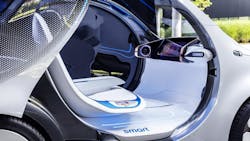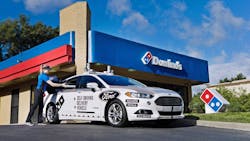Beyond their own forays into crafting cars and trucks that can drive themselves, vehicle manufacturers have been experimenting more with the ways that autonomous vehicles can serve business purposes. And it's looking a lot like Uber.
The key unlocking the potential of connected, self-driving vehicles in business applications is the same one enabling ride-sharing. It's the smartphone, which has placed considerable computing power, wireless and cellular connectivity, and a geo-locatable tracking device in the hands of just about everyone, spreading with ferocious rapidity over the last decade.
Srikanth Padmanabhan, president of engine business at Cummins, Inc., made that point at the company's press event in late August as he spoke of connected vehicle advancements. "Ten years ago if I asked who has one of these to raise your hand, probably less than 5% would have," he said as he held up a smartphone. "Today, 100% of you have this.
"You have WiFi, you have Bluetooth, you have the ability to access data on the cloud. And you now have the ability for artificial intelligence to come together," he added.
Wheeled robot delivery
In terms of what you can do with self-driving vehicles, it was nearly a year ago now that Otto — now Clearpath Robotics, a company that ride-sharing network Uber happens to own — famously delivered a load of Budweiser beer on a 120-mi. route in Colorado with its autonomous tractor-trailer. Aside from transporting freight, what else can you move with a robot vehicle?
Well, people, for starters. That's the focus of Daimler Group's smart vision EQ fortwo concept car displayed at the 2017 Frankfurt International Motor Show. The car offers seating for two people on wheels, with no steering wheel or pedals for that archaic task of actually driving the thing.
The vision EQ fortwo builds on the standard ride-sharing construct, where riders use a smartphone to order a car and specify their intended destination. The smart concept car simply does away with the driver, and a self-driving little vision EQ fortwo zips itself to the customers and then delivers them where they'd like to go.
"The smart vision EQ fortwo heralds a new era in car-sharing: users do not have to look for the next available car. It will find them and collect the passengers directly from their chosen location," Daimler said in a release. A 44-in. black panel at the front of the vehicle and projection surfaces at the sides can display personalized messages, communicating with riders as the car approaches them.
Instead of a bubbly little people-hauler, imagine a self-piloting car that pulls up and you enter a code to open a motorized panel at the side. The panel slides away to reveal a heated compartment holding that pizza you ordered using an app on your smartphone, online or (gasp) maybe even by dialing and speaking to a human...
That's the concept Ford is now exploring with Domino's Pizza. The companies are researching how customers will interact with self-driving cars for food delivery, as outlined above. For now, the testing will be done with a manually-driven Ford Fusion, but randomly selected Domino's customers in Ann Arbor, MI will be able to select an "autonomous" delivery option.
A code delivered to customers' smartphones will allow them to open the pizza compartment on the car. As Ford and Domino's examine how people interact with would-be self-driving cars, one thing they'll test out is whether delivering the goods in a driveway or at the curbside appeals more to customers (not that the former would be an option in many cases, should this technology ever see mass use).
"As Ford builds out its business enabled by self-driving vehicles, conducting research with companies like Domino's will be crucial to ensuring that the technology is applied in ways that enhance the customer experience," the OEM noted. Ford said it plans to begin production of self-driving cars just over three years from now in 2021.
Toward the (uncertain) future
Ford is by no means alone in its exploration of the business uses of autonomous vehicles, but the company was recognized as the leader in self-driving vehicle development back in April under an assessment by Navigant Research. After Ford, Navigant said it found General Motors, the Renault-Nissan Alliance and Daimler are leading in autonomous vehicle systems.
Meanwhile, automobile OEMs have been announcing partnerships and making business development plans and expansions regarding electric-drive vehicles. Analysts such as those at Research and Markets have pointed out that electric vehicles are more conducive to autonomy; EVs, for example, provide a single power source for propulsion, electronics and software, can use simplified drivetrains and don't generate heat as a vehicle powered by an internal combustion engine does.
So as autonomous vehicles advance, look for accompanying applications of and plans for EVs. The Coalition for Future Mobility, an alliance that includes nearly every global automaker as well as groups representing people with special mobility needs and many others, is looking to self-driving vehicles as essentially the answer to many societal problems that exist today.
Such vehicles, the coalition contends, could improve roadway safety, reduce traffic congestion, provide more personal independence for the aging and disabled and allow for greater productivity, all while helping save the environment. That's quite a tall order, and one of the many questions that remains to be answered is whether automating vehicles will leave whole industries — from ride-sharing services to food delivery to freight transporters — of unemployed drivers in its wake.





